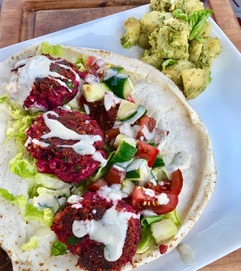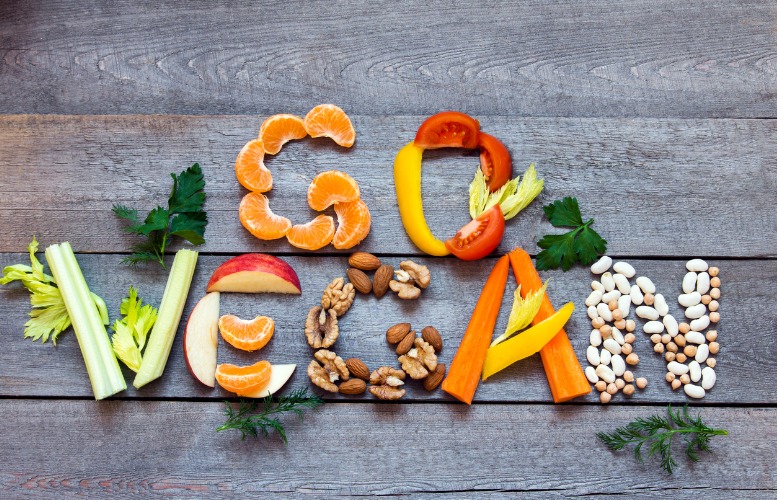5 Ways to Infuse Flavor In Vegan Dishes
Before we set out to learn how we can create more flavorful dishes, we need to define what flavor actually is. Flavor is a combination of taste, mouthfeel, aroma and the “x” factor. Taste is what is perceived by the taste buds, mouthfeel is what is perceived by the rest of the mouth, aroma is what is perceived by the nose, and the “x” factor encompasses all the other senses, plus the heart, mind and spirit. (1) If you are someone new to vegan food, you could try veganizing your favorite dish for instance, to infuse that familiarity you have around it and/or the memories that are attached to it (which is partly why you love it so much).
When we are successful at combining all of the above-mentioned factors, we have created a tasty, balanced and satisfactory meal.
Below are a few tips you can start applying to your daily plant-based meals to make them taste wonderful to anybody who loves food – vegan or not!
1. Use fresh herbs and spices
Make an effort to try one new exotic spice each week and introduce it in a dish you make. Yes, there is more to spices than garlic and onion powder, salt and pepper! Experiment with different curry powders, cumin, coriander, smoked paprika, Middle Eastern and African spices, as well as condiments like hot sauces, mustard, horseradish, vegan Worcestershire sauce, pickled vegetables, curry paste, chutney and Asian chili sauces, to name a few. A dish can go from boring to exhilarating by just adding a dash of either of these!
2. Eat with the seasons and buy local foods
If I had to rate my best tip of all for how to add flavor to your dishes, it would be to cook with seasonal foods and buy local food whenever possible. When produce is in season, it is not only at its most flavorful, but also at its highest nutritional peak. Try eating strawberries in July versus December, for instance – not even a contest! The same goes for tomatoes and eggplant; in the winter they are hard, watery and bland but in the summer months they are juicy, bursting with sweetness and perfectly ripe. Go to your local farmer market and get to know your farmer; this is also a wonderful way to find out what is in season where you live. Buying foods that have only traveled a few miles versus across the country or internationally, will ensure that the flavors and nutrients stay intact and at their freshest.
3. Use vegetable stock instead of water
Infuse flavor in your food wherever you can. Using vegetable stock or broth adds new dimensions to soups, stews, beans, curries and rice dishes. If you are trying to cut down on fat in your diet, sautéing veggies in broth instead of butter or oil is a wonderful way to cook while not sacrificing flavor. If possible, make your own broth from vegetable scraps and a few fresh herbs and spices; it’s so easy and much more flavorful than the store-bought kind.
4. Roast your vegetables instead of steaming them
While steaming takes less time and effort, roasting vegetables brings out their natural sugars and deep flavors with an earthiness and sweetness that can almost taste like a guilty pleasure, yet it’s healthy! Roasted vegetables can be satisfying as a meal in its own, but can be added to pastas, salads, sandwiches and more. The mouthfeel of the vegetables also changes, from just soft and blah when steamed, to crispy and exciting when spending time in the oven. Drizzle with a little olive oil, salt and add some fresh herbs like thyme, oregano or rosemary, place them in the oven and voila; what comes out is a gourmet flavor that will be well worth the extra work.

5. Balance and apply the five flavors of salt, sugar, sour, bitter and ‘umami’
Let’s face it: the reason why food in restaurants taste so much better than the food you make at home is that professional chefs know this secret: you can’t leave out the salt! Salt is the number one ingredient for making savory food taste great. In fact, we are not salting foods to make it salty, but to bring out the flavors in a dish. So many people are afraid of using salt because they think it’s bad for you, when in fact we do need sodium for our brains to function properly. Do make sure that you use good quality salt, like sea salt, Kosher salt or Himalayan salt, versus standard table salt and of course, not over-applying. Another way to add salt naturally is by adding capers, pickles, olives or tapenade into your food; this way you can add a layer of texture as well, which aids in heightening the flavor of a dish.
Sour, or acid, in the form of either lemon, lime juice or vinegar, helps bring out brightness and balance in a meal that may not have been there at the start. Try out different kinds of vinegar like white and red wine, sherry, flavored, balsamic, rice and apple cider vinegar. When you apply vinegar to a dish, it will actually help increase the other flavors of the dish as well and help it go from ‘flat’ to vibrant.
When speaking of sugar, anything from dried fruits to maple and date sugars, coconut sugar and agave are preferable to and have deeper layers of flavor than pure white sugar. Adding a touch of sweetness to spicy foods, for instance, help bring out all the flavors and rounds out the dish.
Bitterness balances sweetness and plays a vital role in cutting richness in a dish. Think of the combination of broccoli rabe or other bitter greens with mashed potatoes, pinches of turmeric, a bitter spice, in a creamy coconut curry or adding mustard to a salad dressing. A little goes a long way here and works very well as a ‘palate cleanser’.
Umami is the fifth flavor that many might have a more difficult time defining. It’s a Japanese term for “pleasant, savory taste” and can be found in foods like sautéed mushrooms, soy sauce, green tea, or a tomato that is ripening under the sun. I find that adding umami flavor to vegan dishes helps recreate that ‘meaty’ flavor many people miss and crave as they are transitioning to a plant-based diet and helps make the dish richer and more satisfying.
Don’t forget we also eat with our eyes, so the visual aspect is equally important. Put care into how you plate a dish, which is guaranteed to heighten the pleasure of eating. Take inspiration from magazines and Instagram, follow food bloggers and food photographers to get ideas on how to compose your plate. And most important of all: have fun with it!
I’ve included a recipe for beet falafels to illustrate some points I’ve discussed here; beets are in season right now in the northeast, I’ve used a plethora of spices and fresh herbs as well as lemon juice to brighten them up. I hope you will enjoy them as much as I do!

Flavor Packed Beet Falafels with a tangy tahini sauce
Makes about 20-24 falafels
- 2 lbs (1 kilo) golden and red beets, washed and peeled
- 2 x 14.5 oz cans (450grams) canned chickpeas, drained and rinsed
- juice and zest of 1 lemon
- 1 small Vidalia onions, diced small
- 4 large garlic cloves, smashed and peeled
- 1 tbsp ground coriander
- 1 tbsp ground cumin
- 2 tsp smoked paprika
- 2 tsp advieh (Persian spice mix – you can omit this if you don’t have)
- a pinch of red pepper flakes
- 1/4 cup (40 grams) walnuts
- a heaping 1/2 cup (80 grams) panko crumbs
- 3 heaping tbsp rice flour
- 1 tsp baking powder
- 1/2 cup or two large handfuls fresh cilantro, chopped
- 1/2 cup or two large handfuls fresh parsley, chopped
- 1/2 cup or two large handfuls fresh dill, chopped
- salt, pepper to taste
Roughly cut up the beets and run them through a food processor with the shredding blade. Alternatively if you don’t have a food processor with the necessary blade, you can use a box grater too. Set the shredded beets aside in a large bowl.
In a medium sauté pan over medium heat with a little olive oil, add the onions and garlic, with a pinch of kosher or sea salt, and sauté for a couple of minutes. Add the ground coriander, cumin, smoked paprika, advieh if using and red pepper flakes along with a couple of pinches of salt and sauté for another 5 minutes or so until the onion is soft and starting to brown.
Carefully transfer the cooked onion mixture into the bowl of a food processor along with the shredded beets, lemon zest, lemon juice, chickpeas, walnuts and a little salt and pepper and pulse until you get a rough mixture (I don’t like it too smooth as I like a little bit of texture/resistance). You might have to do this in two rounds as it is a lot of food.
Transfer the pulsed mixture to a large bowl and fold in the panko, rice flour, baking powder, fresh cilantro, parsley, dill, salt and pepper and combine well. You can test out a small ball of the falafel dough on a sauté pan to see if you’ve seasoned it appropriately.
Using your hands, scoop up some of the mixture and form it into a ball in your hand. The exact amount doesn’t matter — just make sure that all your falafel balls are roughly the same size, so they bake at the same rate. Place on a tray lined with a baking sheet and place in fridge while you prepare the tahini sauce.
Heat up a little olive oil in a large sauté pan, and fry up 5-6 patties/ falafel balls at a time until golden on both sides. Transfer to a sheet tray lined with paper towel to drain some of the fat off. Serve on top of warm pita bread and drizzle with tahini sauce. I also like to make a side salad of romaine lettuce, tomatoes and cucumbers for a cooling crunch.
Tahini Sauce
- 1 cup vegan yogurt (I like Forager)
- juice and zest of 1 lemon
- 3 tbsp tahini
- salt, pepper
Whisk everything together in a small bowl and set aside or put in fridge until ready to use.
Reference
1 Page, Karen and Dornenburg, Andrew, The Flavor Bible. New York: Little, Brown and Company. 2008. Print.

Sunny is a vegan lifestyle consultant, chef, wine educator and food blogger. She works with both private and corporate clients, helping people transition to a plant-based diet and vegan way of life, as well as operating as a consultant for restaurants and other food establishments who are looking to veganize their food menus and wine lists. Sunny is the wine director for Vegan Wines, the first vegan online wine club in the United States, and is passionate about animal advocacy. She lives in Beacon, NY with her husband and three dogs: Scooby, Tofu and Nacho. You can contact sunny by email sunny@sunnygandara.com.



